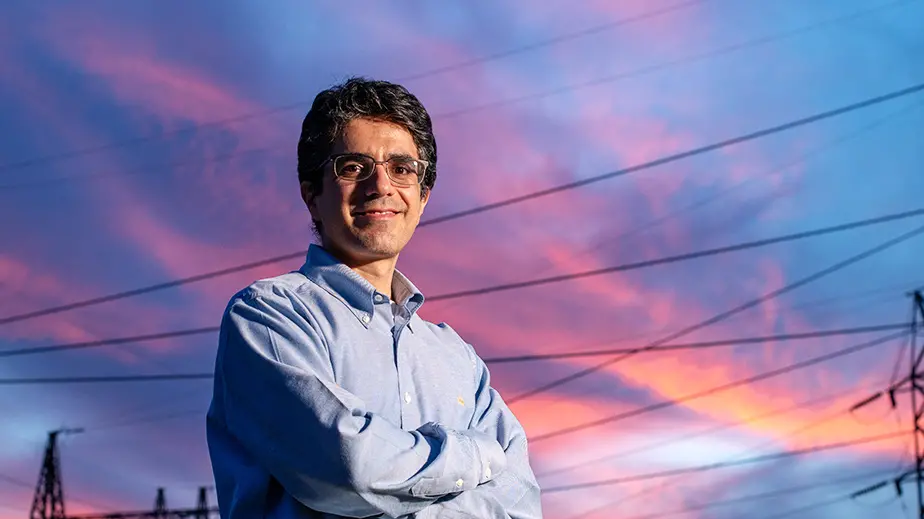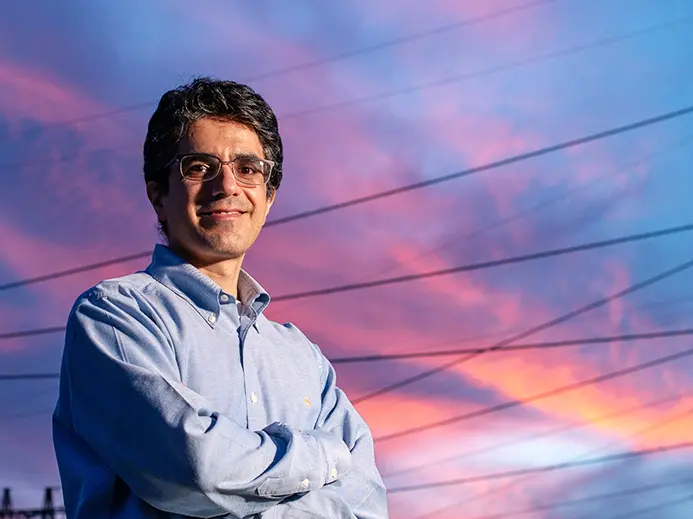

When hackers, harsh weather and inequality arise
Professor Abdollah Shafieezadeh answers alumni questions about why the U.S. needs to act now to secure the power grid for the future.
The United States’ energy grid was largely built in the 1950s and ’60s — before climate change, cybersecurity threats and a host of other challenges arrived on the scene. Today, power grid failures are increasingly common across the country. In particular, a trio of winter storms that left millions without electricity in Texas in early 2021 — leading to shortages of food, water and heat — captured the nation’s attention, and lower-profile outages occur with regularity.
Abdollah Shafieezadeh, director of the Ohio State College of Engineering’s RAMSIS Lab (Risk Assessment and Management of Structural and Infrastructure Systems), studies the risks our infrastructure systems face and helps inform strategic plans to meet these challenges. The Lichtenstein Endowed Professor of Civil, Environmental and Geodetic Engineering recently answered your questions about these potential crises.
-
Geographically, what areas are of greatest concern? What presents the most potential for catastrophe? — Lisa Nabors Rhude ’91
A study by the National Oceanic and Atmospheric Administration collected and analyzed data on the impact of natural disasters around the country since 1980. It looked at billion-dollar disasters, major events like drought, flooding, freezing, sea storms, tropical cyclones, wildfires and winter storms.
They found the South has experienced the highest cumulative damage costs. That reflects the high diversity and frequency of severity of the weather and climate extremes that happen in that region. Texas, for example, experienced the highest number of billion-dollar disasters, over 110. It’s one of the few states impacted by all seven disaster types.
As far as the potential for catastrophes, there are a few. What they have in common is they happen without warning: An earthquake comes without warning. Cyberattacks are a huge concern. And climate change is a major concern because it is changing the way natural hazards are occurring.
-
Can power grid systems really be hacked? If so, what level of security do they need? — Sarthak Gupta ’21
The power grid is a complex cyber-physical system, meaning it integrates sensors, computational power, control and networking capabilities into a physical system. These cyber-physical systems are commonly connected to the internet for efficiency. That’s where the vulnerability stems from.
There was a study in 2015 that simulated a cyberattack on the eastern interconnection of the U.S. grid. The simulation targeted power generators. By only shutting down 10%, it created blackouts in 15 states and left 93 million people without power.
So yes, it can be hacked, and we need the highest possible security.
-
What would it cost to upgrade, modernize and properly secure the U.S. power grid? — Jeffrey Pascoe ’87
To replace everything, the estimated cost would be around $5 trillion. Of course, we don’t need to completely rebuild the grid. If we focus on, let’s say, climate change as a key driver of future vulnerability, it may impact many elements of the power grid. One estimate indicated to prepare for substantive hazards would cost $120 billion to $380 billion through 2099.
Many studies indicate this investment would reduce costs of the power grid by almost 50%. That’s a significant savings if we invest early and strategically.
-
Do you recommend that people who live in cities or suburbs set up their own backup power source? — Michelle Cooper ’96
For important facilities like hospitals, police stations or fire stations, it’s a must to have backup systems. That can be extended to households. The technology is getting more efficient and costs are going down.
One thing to be mindful of is the disparities it may cause. Although some of these technologies are subsidized, even the subsidized technologies are not affordable by a large portion of the population. What we could end up having is the people who can afford it gain a resilient system and may not even need to pay for the grid given normal conditions, so less people would contribute to maintaining the grid. Then the cost of maintaining the grid transfers to people who can’t afford these technologies. So the cost of their electricity increases, and they suffer the most during outages.
-
What should the United States prioritize in the next five years, 10 years and 20 years? — Jose Blanco ’04
The grid is facing a multitude of challenges. One issue we see is there’s no national standard that adequately addresses these problems. And time is running out. We need to develop strategic plans and implement them now.



